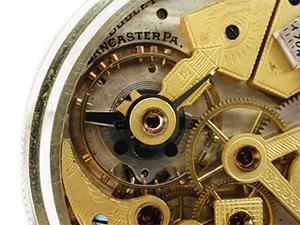
Reverse Face of the Dudley Model 2
|
If ever any watch design was more famous for the design of the internal watch structure rather than it's face or case design its the Dudley.
In 1918, William Wallace Dudley began work on the production of a Masonic watch with its bridge plate in the form of Masonic symbols (a slipper, plumb, trowel, level, square, compass, the letter G. and a Bible). The plates were machined by his friend, Willis R. Michael, also a Freemason. Dudley later applied for and was granted patents for the Masonic plate design dated June 29, 1923. According to his daughter, Dudley had been planning his Masonic watch for 15 to 20 years prior to being granted the patent for the design.
George W. Adams and John D. Wood, local retail jewelers and both Masons, became Dudley's business partners. On May 20, 1920 they applied to the State of Pennsylvania for incorporation. The amount of capital stock of the corporation was $5,000. Property was acquired at South West End and Maple Avenue in Lancaster, PA.
|
.The original plan was to design and build a 14-size pocket watch. The first 14 size, 19 jewel watch, in 14K gold case was produced in 1922. This pocket watch was referred to as the Model 1 and used many parts from the Waltham models 1894 and 1897 including the train and escapement. Plates and winding mechanism were made at the Dudley factory, while dials and hands were produced in Switzerland to Dudley's specifications. Cases for Dudley watches were produced by Wadsworth, Keystone and Star Watch Case companies
|
| By 1923, the Dudley Watch Company experienced heavy competition and dwindling sales of their larger 14-size watches. Responding to the customers desire for a smaller pocket watch, they decided to produce a 12-size, 19 jewel, 14K gold-filled watch which was referred to as the Model 2. The Model 2 differs from the Model 1 by having a silver colored Bible mounted so as to cover the winding pinion which was previously exposed. This watch used the wheels and escapement design from the Hamilton 910 and 912 models.
At full production the company employed 18-20 men including Arthur and Clifford Dudley, sons of the founder. Since the manufacturing consisted primarily of assembling the parts, the employees were all skilled watchmakers and most were Masons, many of whom were previously employed by the Hamilton Watch Company.
|
 |
Depending on the style of the case, the cost of a Dudley Masonic Watch ranged from $125 to $250. Sales began to decline with the introduction of the wristwatch and by late 1924 the company was heavily in debt. On February 28, 1925 a petition for bankruptcy was filed in the U.S. District Court in Philadelphia.
Dudley had invested all of his available capital in his watch company, and at the age of 74 found himself out of work and nearly destitute. He returned to the Hamilton Watch Company as a mechanic where he continued to work until 1931, retiring at the age of 80.
On February 9, 1938 Dudley died at Lancaster, Pennsylvania. He never lived to see the Dudley Masonic Watch become a valuable, sought after collector's item. While the company produced other watches, it is the Masonic watch for which Dudley is most famous, and they continue to be highly-prized by both watch collectors and Masons. The Masonic watch continued to be produced by the P. W. Baker Company from 1925 to 1935, and by the XL Watch Company of New York from 1935 to 1976. |
| |
|
|
|
|
| |
|
|
|
|
| |
|
|
|
|
| |
|
|
|
|
| |
|
|
|
|
| |
|
|
|
|
| |
|
|
|
|
|